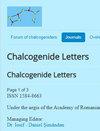Influence of annealing on the properties of chemically prepared SnS thin films
IF 1.2
4区 材料科学
Q4 MATERIALS SCIENCE, MULTIDISCIPLINARY
引用次数: 0
Abstract
Thin films of SnS were deposited chemically, and they are annealed at four different temperatures: 100 °C, 150 °C, 200 °C, and 250 °C. X-ray diffraction, Raman analysis, UV-visible spectroscopy, field emission scanning electron microscopy, and energy dispersive spectroscopy were used to investigate the impact of annealing temperature on the structural, optical, morphological, and chemical properties of thin films. As the annealing temperature rose, it was seen from the XRD patterns that the crystallinity of SnS films improved. At 250 °C, the film was almost evaporated, and the XRD pattern showed no peaks at all. The lattice strain and crystallite size were computed from the WilliamsonHall plots. The crystallite size increased and the lattice strain decreased with the increase in the annealing temperature. According to optical investigations, the samples' optical bandgap shrank as the annealing temperature rose. Morphological studies showed the formation of well-adhered films, and as the annealing temperature increased, the film became denser and more continuous with larger grains. The atomic weight percentage of sulphur decreased as the annealing temperature increased, according to the EDS analysis. Photovoltaic structures with the configuration ITO/SnS/CdS/Ag were fabricated. From the I-V characteristics, it was observed that the cell structure formed with SnS annealed at 200 °C showed better cell performance.退火对化学制备的SnS薄膜性能的影响
SnS薄膜是化学沉积的,并在四个不同的温度下退火:100°C、150°C、200°C和250°C。利用X射线衍射、拉曼光谱、紫外可见光谱、场发射扫描电子显微镜和能量色散光谱研究了退火温度对薄膜结构、光学、形态和化学性能的影响。从XRD图谱可以看出,随着退火温度的升高,SnS薄膜的结晶度有所提高。在250°C下,薄膜几乎蒸发,XRD图谱显示完全没有峰。晶格应变和晶粒尺寸由WilliamsonHall图计算。随着退火温度的升高,晶粒尺寸增大,晶格应变减小。根据光学研究,样品的光学带隙随着退火温度的升高而缩小。形态研究表明,形成了粘附良好的薄膜,随着退火温度的升高,薄膜变得更致密、更连续,晶粒更大。根据EDS分析,硫的原子量百分比随着退火温度的升高而降低。制备了ITO/SnS/CdS/Ag结构的光伏结构。从I-V特性可以观察到,在200°C下退火的SnS形成的电池结构显示出更好的电池性能。
本文章由计算机程序翻译,如有差异,请以英文原文为准。
求助全文
约1分钟内获得全文
求助全文
来源期刊

Chalcogenide Letters
MATERIALS SCIENCE, MULTIDISCIPLINARY-PHYSICS, APPLIED
CiteScore
1.80
自引率
20.00%
发文量
86
审稿时长
1 months
期刊介绍:
Chalcogenide Letters (CHL) has the aim to publish rapidly papers in chalcogenide field of research and
appears with twelve issues per year. The journal is open to letters, short communications and breakings news
inserted as Short Notes, in the field of chalcogenide materials either amorphous or crystalline. Short papers in
structure, properties and applications, as well as those covering special properties in nano-structured
chalcogenides are admitted.
 求助内容:
求助内容: 应助结果提醒方式:
应助结果提醒方式:


